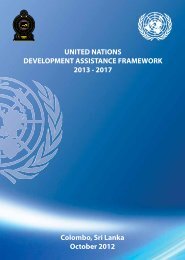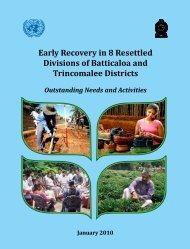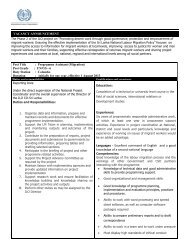Sri Lanka Human Development Report 2012.pdf
Sri Lanka Human Development Report 2012.pdf
Sri Lanka Human Development Report 2012.pdf
Create successful ePaper yourself
Turn your PDF publications into a flip-book with our unique Google optimized e-Paper software.
HDI= (I Life Expectancy ) 1 / 3 × (IEducation ) 1 / 3 × (IIncome ) 1 / 3<br />
I Life Expectancy =Life Expectancy Index=<br />
Life Exp.of the country or district -<br />
Mini. observed Life Exp.<br />
Max.observed Life Exp.- Mini.observed Life Exp.<br />
A country’s overall HDI can conceal the fact that different<br />
regions, districts or sectors within the country have very different<br />
levels of human development. Sub-national HDIs are calculated<br />
by using the data for the HDI dimensions and indicators at the<br />
sub-national levels, such as regions or districts. Disaggregated<br />
HDIs help to draw attention to disparities and gaps.<br />
For more details on the methodological aspects of the HDI, see<br />
Technical Note 2 of United Nations <strong>Development</strong> Programme<br />
2011a. The Statistical Annex of UNDP 2011a, provides the<br />
recalculated HDI values (Table T2) for <strong>Sri</strong> <strong>Lanka</strong>, based on the<br />
new goalposts for HDI.<br />
Atkinson (1970) family of inequality measures.The IHDIis<br />
computed as a geometric mean of geometric means, calculated<br />
across the population for each dimension separately. It accounts<br />
for inequalities in HDI dimensions by discounting each<br />
dimension’s average value according to its level of inequality.<br />
The IHDI equals the HDI when there is no inequality across<br />
people, but is less than the HDI as inequality rises. In this sense,<br />
the IHDI is the actual level of human development (accounting<br />
for this inequality), while the HDI can be viewed as an index of<br />
‘potential’ human development (or the maximum level of HDI)<br />
that could be achieved without inequality. The ‘loss’ in potential<br />
Table T.2: <strong>Sri</strong> <strong>Lanka</strong>: Recalculated HDI Value, 1980-2011<br />
Year 1980 1990 2000 2005 2009 2010 2011<br />
Recalculated HDI 0.539 0.583 0.633 0.662 0.680 0.686 0.691<br />
Source: United Nations <strong>Development</strong> Programme 2011a.<br />
Inequality-adjusted <strong>Human</strong> <strong>Development</strong> Index<br />
The IHDIadjusts the HDI for inequality in the distribution<br />
of each dimension across the population. It is based on a<br />
distribution-sensitive class of composite indices proposed by<br />
Foster, Lopez-Calva and Szekely (2005), which draws on the<br />
human development due to inequality is given by the difference<br />
between the HDI and the IHDI, and can be expressed as a<br />
percentage.<br />
The IHDI is the mean of the three dimension indicators adjusted<br />
for inequality.<br />
HDI= 3 √ (1 - A Life ) (1 - A Education ) (1 - A Income ) × HDI<br />
where A Life = Atkinson Inequality Measure for Life Expectency<br />
A Education = Atkinson Inequality Measure for Education<br />
A Income = Atkinson Inequality Measure for Income<br />
168<br />
sri lanka <strong>Human</strong> <strong>Development</strong> report 2012






